整理初中英语试讲听力教案
- 格式:docx
- 大小:20.34 KB
- 文档页数:4
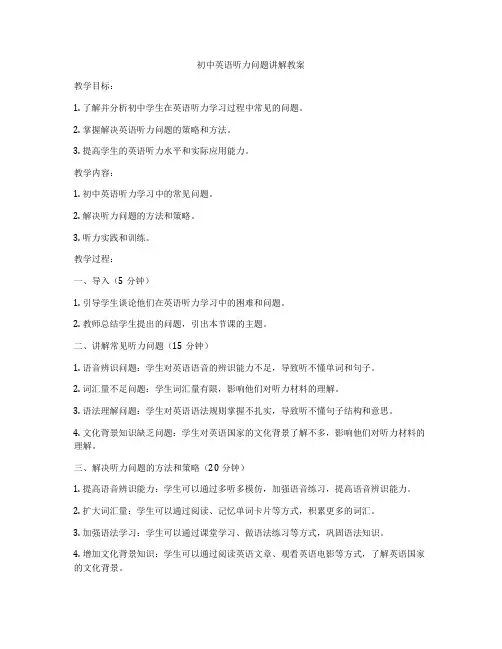
初中英语听力问题讲解教案教学目标:1. 了解并分析初中学生在英语听力学习过程中常见的问题。
2. 掌握解决英语听力问题的策略和方法。
3. 提高学生的英语听力水平和实际应用能力。
教学内容:1. 初中英语听力学习中的常见问题。
2. 解决听力问题的方法和策略。
3. 听力实践和训练。
教学过程:一、导入(5分钟)1. 引导学生谈论他们在英语听力学习中的困难和问题。
2. 教师总结学生提出的问题,引出本节课的主题。
二、讲解常见听力问题(15分钟)1. 语音辨识问题:学生对英语语音的辨识能力不足,导致听不懂单词和句子。
2. 词汇量不足问题:学生词汇量有限,影响他们对听力材料的理解。
3. 语法理解问题:学生对英语语法规则掌握不扎实,导致听不懂句子结构和意思。
4. 文化背景知识缺乏问题:学生对英语国家的文化背景了解不多,影响他们对听力材料的理解。
三、解决听力问题的方法和策略(20分钟)1. 提高语音辨识能力:学生可以通过多听多模仿,加强语音练习,提高语音辨识能力。
2. 扩大词汇量:学生可以通过阅读、记忆单词卡片等方式,积累更多的词汇。
3. 加强语法学习:学生可以通过课堂学习、做语法练习等方式,巩固语法知识。
4. 增加文化背景知识:学生可以通过阅读英语文章、观看英语电影等方式,了解英语国家的文化背景。
四、听力实践和训练(15分钟)1. 学生听一段英语对话或短文,注意观察并记录下自己在听力过程中遇到的问题。
2. 学生分组讨论,分享彼此在听力过程中遇到的问题和解决方法。
3. 教师提供一些听力练习材料,学生进行听力练习,尝试运用所学的方法和策略解决问题。
五、总结和反思(5分钟)1. 学生总结本节课所学的内容和收获。
2. 教师鼓励学生继续努力,不断提高自己的英语听力水平。
教学评价:1. 观察学生在听力实践中的表现,评估他们的听力水平提高情况。
2. 学生反馈他们在听力学习中的困难和问题,以及解决方法的有效性。
3. 定期进行听力测试,评估学生的听力成绩进步情况。
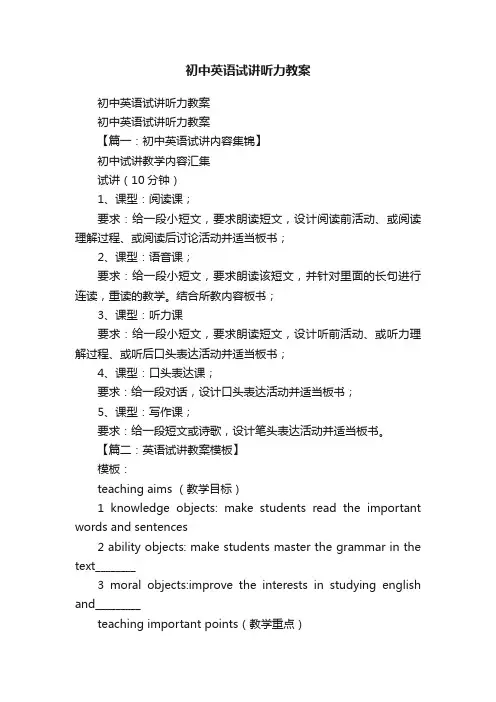
初中英语试讲听力教案初中英语试讲听力教案初中英语试讲听力教案【篇一:初中英语试讲内容集锦】初中试讲教学内容汇集试讲(10分钟)1、课型:阅读课;要求:给一段小短文,要求朗读短文,设计阅读前活动、或阅读理解过程、或阅读后讨论活动并适当板书;2、课型:语音课;要求:给一段小短文,要求朗读该短文,并针对里面的长句进行连读,重读的教学。
结合所教内容板书;3、课型:听力课要求:给一段小短文,要求朗读短文,设计听前活动、或听力理解过程、或听后口头表达活动并适当板书;4、课型:口头表达课;要求:给一段对话,设计口头表达活动并适当板书;5、课型:写作课;要求:给一段短文或诗歌,设计笔头表达活动并适当板书。
【篇二:英语试讲教案模板】模板:teaching aims (教学目标)1 knowledge objects: make students read the important words and sentences2 ability objects: make students master the grammar in the text________3 moral objects:improve the interests in studying english and_________teaching important points(教学重点)words:_________________________________sentences:_______________________________________________________________________________teaching difficult points(教学难点)master the grammaruse the words in their lives____________________teaching aids(教具)cards、projectors _________ __________ ________teaching procedure:(教学过程)step1 leading-instep 2 __________........step n homeworkblackboard design (板书设计)(一)形式教案是教学设计的文字体现,有相对的格式与要求。
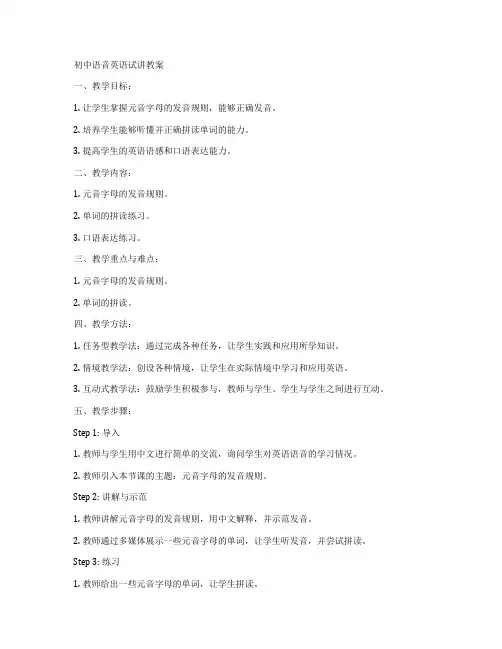
初中语音英语试讲教案一、教学目标:1. 让学生掌握元音字母的发音规则,能够正确发音。
2. 培养学生能够听懂并正确拼读单词的能力。
3. 提高学生的英语语感和口语表达能力。
二、教学内容:1. 元音字母的发音规则。
2. 单词的拼读练习。
3. 口语表达练习。
三、教学重点与难点:1. 元音字母的发音规则。
2. 单词的拼读。
四、教学方法:1. 任务型教学法:通过完成各种任务,让学生实践和应用所学知识。
2. 情境教学法:创设各种情境,让学生在实际情境中学习和应用英语。
3. 互动式教学法:鼓励学生积极参与,教师与学生、学生与学生之间进行互动。
五、教学步骤:Step 1: 导入1. 教师与学生用中文进行简单的交流,询问学生对英语语音的学习情况。
2. 教师引入本节课的主题:元音字母的发音规则。
Step 2: 讲解与示范1. 教师讲解元音字母的发音规则,用中文解释,并示范发音。
2. 教师通过多媒体展示一些元音字母的单词,让学生听发音,并尝试拼读。
Step 3: 练习1. 教师给出一些元音字母的单词,让学生拼读。
2. 教师选取一些学生发音不准确的单词,进行个别指导。
3. 学生分组,互相练习发音。
Step 4: 应用1. 教师创设一个情境,让学生用所学知识进行口语表达。
2. 学生进行口语表达练习,教师进行评价和指导。
Step 5: 总结与作业1. 教师对本节课的内容进行总结,强调元音字母的发音规则。
2. 教师布置作业:让学生课后找一些元音字母的单词进行拼读练习,并尝试用所学知识进行口语表达。
六、教学反思:通过本节课的教学,发现学生在元音字母的发音方面存在一些问题,需要在今后的教学中进行重点讲解和练习。
同时,学生在口语表达方面也存在一定的困难,需要教师创设更多的情境,让学生在实际情境中练习和应用英语。
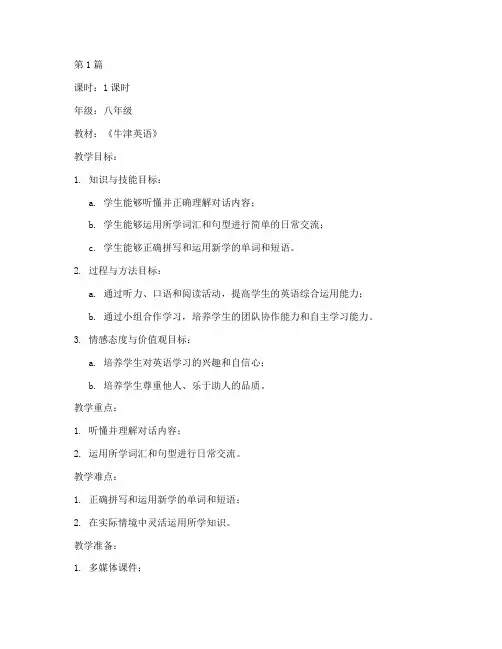
第1篇课时:1课时年级:八年级教材:《牛津英语》教学目标:1. 知识与技能目标:a. 学生能够听懂并正确理解对话内容;b. 学生能够运用所学词汇和句型进行简单的日常交流;c. 学生能够正确拼写和运用新学的单词和短语。
2. 过程与方法目标:a. 通过听力、口语和阅读活动,提高学生的英语综合运用能力;b. 通过小组合作学习,培养学生的团队协作能力和自主学习能力。
3. 情感态度与价值观目标:a. 培养学生对英语学习的兴趣和自信心;b. 培养学生尊重他人、乐于助人的品质。
教学重点:1. 听懂并理解对话内容;2. 运用所学词汇和句型进行日常交流。
教学难点:1. 正确拼写和运用新学的单词和短语;2. 在实际情境中灵活运用所学知识。
教学准备:1. 多媒体课件;2. 教学用书;3. 听力材料;4. 白板或黑板;5. 练习题。
教学过程:一、导入(5分钟)1. 利用图片、歌曲或游戏等形式,激发学生的学习兴趣。
2. 引导学生复习上节课所学内容,为新课的讲解做好铺垫。
二、新课讲解(20分钟)1. 介绍本节课所学的新单词和短语,并进行拼写练习。
2. 播放听力材料,让学生听懂对话内容。
3. 分析对话中的语法结构和词汇运用,引导学生进行跟读和模仿。
4. 通过角色扮演,让学生在真实情境中运用所学知识进行交流。
三、课堂活动(25分钟)1. 小组讨论:将学生分成若干小组,讨论对话中的问题,如:a. 对话中的人物是谁?b. 对话发生在什么地点?c. 对话的主要内容是什么?2. 角色扮演:让学生分组进行角色扮演,巩固所学知识。
3. 语法练习:设计一些与新课内容相关的语法练习题,让学生在练习中提高语法运用能力。
四、课堂小结(5分钟)1. 回顾本节课所学内容,强调重点和难点。
2. 鼓励学生在课后继续复习和巩固所学知识。
五、作业布置(5分钟)1. 完成课后练习题;2. 复习本节课所学单词和短语;3. 准备下节课的课堂活动。
教学反思:1. 教学过程中,注意关注学生的学习情况,及时调整教学策略。
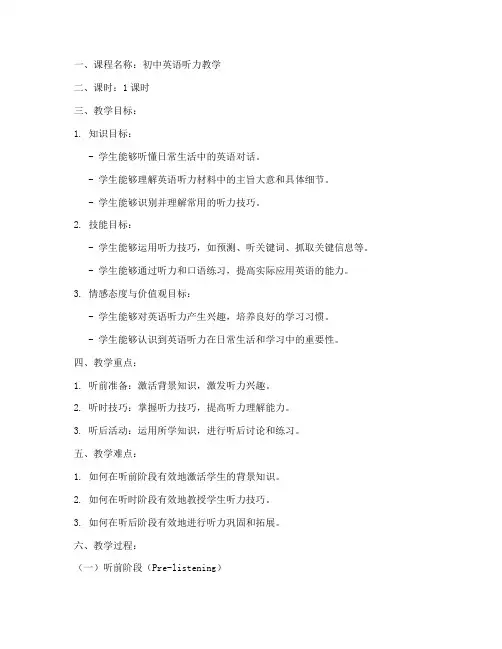
一、课程名称:初中英语听力教学二、课时:1课时三、教学目标:1. 知识目标:- 学生能够听懂日常生活中的英语对话。
- 学生能够理解英语听力材料中的主旨大意和具体细节。
- 学生能够识别并理解常用的听力技巧。
2. 技能目标:- 学生能够运用听力技巧,如预测、听关键词、抓取关键信息等。
- 学生能够通过听力和口语练习,提高实际应用英语的能力。
3. 情感态度与价值观目标:- 学生能够对英语听力产生兴趣,培养良好的学习习惯。
- 学生能够认识到英语听力在日常生活和学习中的重要性。
四、教学重点:1. 听前准备:激活背景知识,激发听力兴趣。
2. 听时技巧:掌握听力技巧,提高听力理解能力。
3. 听后活动:运用所学知识,进行听后讨论和练习。
五、教学难点:1. 如何在听前阶段有效地激活学生的背景知识。
2. 如何在听时阶段有效地教授学生听力技巧。
3. 如何在听后阶段有效地进行听力巩固和拓展。
六、教学过程:(一)听前阶段(Pre-listening)1. 热身活动:- 组织学生进行简单的英语口语交流,如问好、介绍自己等。
- 通过图片、视频或话题讨论,激活学生的背景知识。
2. 导入新课:- 以相关话题提出问题,引导学生进行思考。
- 介绍听力材料的内容和背景,降低听力难度。
3. 预测任务:- 鼓励学生根据图片、标题或问题预测听力材料的内容。
(二)听时阶段(While-listening)1. 听力技巧:- 教授学生听力技巧,如预测、听关键词、抓取关键信息等。
- 通过示范和练习,让学生掌握这些技巧。
2. 听力材料:- 播放听力材料,让学生进行听力练习。
- 引导学生注意听力材料的细节,如人物、时间、地点等。
3. 互动活动:- 在听力过程中,适时提问,检查学生的听力理解情况。
- 鼓励学生进行小组讨论,分享听力心得。
(三)听后阶段(Post-listening)1. 总结与反思:- 让学生总结听力材料的主要内容,分享听力心得。
- 引导学生反思自己在听力过程中的优点和不足。
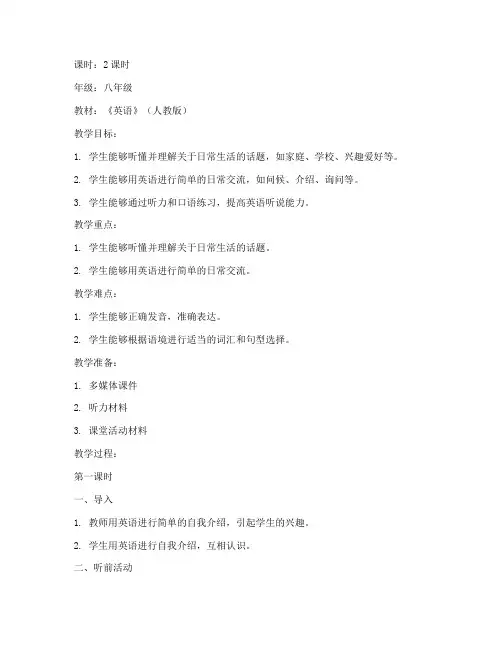
课时:2课时年级:八年级教材:《英语》(人教版)教学目标:1. 学生能够听懂并理解关于日常生活的话题,如家庭、学校、兴趣爱好等。
2. 学生能够用英语进行简单的日常交流,如问候、介绍、询问等。
3. 学生能够通过听力和口语练习,提高英语听说能力。
教学重点:1. 学生能够听懂并理解关于日常生活的话题。
2. 学生能够用英语进行简单的日常交流。
教学难点:1. 学生能够正确发音,准确表达。
2. 学生能够根据语境进行适当的词汇和句型选择。
教学准备:1. 多媒体课件2. 听力材料3. 课堂活动材料教学过程:第一课时一、导入1. 教师用英语进行简单的自我介绍,引起学生的兴趣。
2. 学生用英语进行自我介绍,互相认识。
二、听前活动1. 教师简要介绍听力材料的内容,让学生对即将听到的内容有所了解。
2. 学生根据教师提供的图片或文字,预测听力材料的内容。
三、听力练习1. 学生独立完成听力练习,教师播放听力材料。
2. 学生回答问题,教师点评并纠正错误。
四、口语练习1. 学生根据听力材料的内容,用英语进行简单的口语表达。
2. 教师组织学生进行小组讨论,分享自己的观点。
五、总结与作业1. 教师总结本节课的学习内容,强调重点和难点。
2. 布置课后作业,要求学生复习所学内容。
第二课时一、复习导入1. 教师组织学生复习上一节课的学习内容,巩固所学知识。
2. 学生用英语进行简单的口语表达,展示自己的学习成果。
二、听前活动1. 教师简要介绍听力材料的内容,让学生对即将听到的内容有所了解。
2. 学生根据教师提供的图片或文字,预测听力材料的内容。
三、听力练习1. 学生独立完成听力练习,教师播放听力材料。
2. 学生回答问题,教师点评并纠正错误。
四、口语练习1. 学生根据听力材料的内容,用英语进行简单的口语表达。
2. 教师组织学生进行角色扮演,模拟实际生活场景。
五、总结与作业1. 教师总结本节课的学习内容,强调重点和难点。
2. 布置课后作业,要求学生复习所学内容,并尝试用英语进行日常交流。
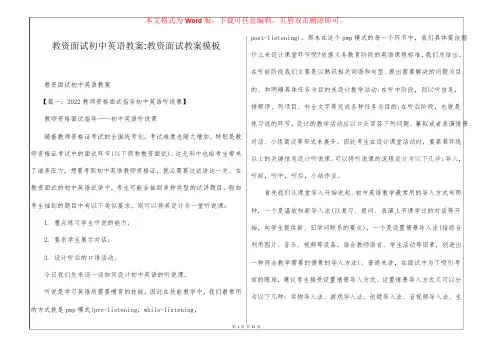
教资面试初中英语教案:教资面试教案模板教资面试初中英语教案【篇一:2022教师资格面试指导初中英语听说课】教师资格面试指导——初中英语听说课随着教师资格证考试的全国统考化,考试难度也随之增加,特别是教师资格证考试中的面试环节(以下简称教资面试)。
这无形中也给考生带来了诸多压力,想要考取初中英语教师资格证,就必需要过试讲这一关。
在教资面试的初中英语试讲中,考生可能会抽到多种类型的试讲题目。
假如考生抽到的题目中有以下类似要求,则可以将其设计为一堂听说课:1. 重点练习学生听说的能力;2. 要求学生展示对话;3. 设计听后的口语活动。
今日我们先来谈一谈如何设计初中英语的听说课。
听说是学习英语所需要哺育的技能,因此在技能教学中,我们最常用的方式就是pwp模式(pre-listening,while-listening,post-listening)。
那末在这个pwp模式的每一个环节中,我们具体要依据什么来设计课堂环节呢?依据义务教育阶段的英语课程标准,我们总结出,在听前阶段我们主要是以熟识相关词语和句型、提出需要解决的问题为目的、和明确具体任务为目的来设计教学活动;在听中阶段,则以听信息,排顺序、列项目、补全文字等完成各种任务为目的;在听后阶段,也就是练习说的环节,设计的教学活动应以口头回答下列问题、摹拟或者表演情景对话、小组商议等形式来展开。
因此考生在设计课堂活动时,要紧紧环绕以上的关键信息设计听说课。
可以将听说课的流程设计为以下几步:导入,听前,听中,听后,小结作业。
首先我们从课堂导入开始说起。
初中英语教学最常用的导入方式有两种,一个是温故知新导入法(以复习、提问、表演上节课学过的对话等开始,向学生提供新、旧学问联系的要点),一个是设置情景导入法(指综合利用图片、音乐、视频等设备,结合教师语言、学生活动等因素,创造出一种符合教学需要的情景的导入方法)。
普通来讲,在面试中为了吸引考官的眼球,建议考生接受设置情景导入方式。

七年级英语听力教案英文版5篇七年级英语听力教案英文版5篇教师要在自己钻研教材的基础上,广泛地涉猎多种教学参考资料,向有经验的老师请教,而不要照搬照抄,要汲取精华,去其糟粕,对别人的经验要经过一番思考、消化、吸收,独立思考,然后结合个人的教学体会,巧妙构思,精心安排,从而写出自己的教案。
以下是带来的七年级英语听力教案英文版内容,感谢您的阅读,希望能帮助到您!七年级英语听力教案英文版1unit 5 text awhat are friends for? teaching objectives:by the end of the unit, students will be better able to1.understand the varied parts friendship plays in ones life and be betterfriends themselves;e about 30 new words and 10 new phrases and expreions in briefconversations, translation and preliminary writing tasks;e the subjunctive mood with implied condition in real lifecommunication;4.read material of a similar topic and degree of difficulty;5.know how towrite concisely by avoidingoverstated, pompous words and redundant phrases.teaching methods:audio lingual method; presentation; discuion; question-answer.important/difficult points:new words and expreions: chat, turtle, modelpick up, happen to, cd player, out of touch, put in perspective, betrayedconfidence on the planet, get rid of, in good/bad shapesome sentences in the text are difficult to understand, such as i wasthinking about how everybody can’t be every thing to each other, but some peoplecan be something to each other, but some people can be something to each other;wherever, whenever, there’s that spark of recognition; they have beautiful homesfilled with special handmade things presented to them by villagers in the remoteareas they have visited in their extensive travels. teaching procedure:step 1.warming up (30 mints)1) work in pairs or groups, and discu the following questions.? 1.do you have different kinds of friends? how do youclaify them?? 2.what is so great about friends?? 3.under what circumstances can one lose a friend?? 4.is it poible to love and hate a friend at the same time? giveexamples.2) ask students to skim the text for the 8 kinds of friends mentioned inthe text.buddies/ relative friends/ work friends/ former friends/ friends you loveto hate/ hero friends/ new friends 3) introducing the main idea of thearticleit is said that friends are the best gift god has given us.now that we haveeight kinds of friends from the text, what kind of happine or benefit can eachof them bring us? that’s exactly what the text is about.step 2.new words and the notes (20 mints) learn new words and expreions oftext aexplain some important and difficult words and expreions. cement n.水泥,粘合剂v巩固,粘牢nostalgic a.—nostalgia n.—nostalgically ad. subdivision n.—subdividev.—divide v. inopportune a.—(opposite) opportune a. invisible a.—(opposite)visible a. look at the notes on page 1161.marion wink: poet, eayist, and regular commentator on national publicradio’s.the author made up the capitalized expreions in th e text such as“faraway friend,” “relative friend,” which would make no sense at all out ofcontext, with the latter in particular.2.you quit doing drugs, you’re not such good friends with your dealeranymore: this is not meant to be taken seriously.poeion or sale of illegal drugscan result in long prison terms.step 3.key points (60 minutes)? 1.cry on sb.’s shoulder: get sympathy from someone when you tell themyour problems 向某人诉苦以寻求安慰(或同情)e.g.at least she hadn’t cried on his shoulder again.if you ever need ashoulder to cry on, just call me.? 2.in return (for sth.): as payment or reward for something作为报答或回报e.g.he is always helping people without expecting anything in return.we offer an excellent all-round(全面的,多方面的) education to our students.inreturn, we expect students to work hard. ? 3.they hold out through innumerablecrisesbefore...: they are alwaysreliable(可靠的,可信信赖的) and nice when you are in difficult times even thoughthey don’t like what you are doing... ? 4.while so many family relationships aretinged with guilt andobligation:while so many people may feel something of a sense of guilt orresponsibility in dealing with family relationships...? pany goip, once an infallible(绝对可靠的) source ofentertainment, soon awkwardly accentuates the distance between you: officechat used to be an effective way of amusement for you; however, it makes youfeel uneasy since you do not work together anymore and therefore increases thefeeling of distance between you.? 6.work friends share certain memories which acquire a nostalgic glowafter about a decade:memories of your work friends makes you happy after ten years, so yousomehow wish that you could return to those days.? 7.dead end: a street with no way out at one end or a situation from whichnomore progre in poiblee.g.he realized that the job at which he had been aiming all theseyearsseemed to him to be a dead end. he thinks they have reached anevolutionary(逐渐发展的,演变的) dead end.? 8.when you feel you’ve hit a dead end, come to a confusing fork intheroad, or gotten lost in some cracker-box subdivision of your life:whenever you feel helple, confused or at a lo(困惑的,不知所措的) in the complicatedjourney of your life...notice that “cracker-box division” is not a general expreion, but is rathermade up by the author.cracker: 薄脆饼干;咸饼干sth.: formal owning or having obtainedsomething from somewhere 占有(或拥有)某物e.g.she was found in poeion of stolen goods.how did the painting come into your poeion (=how did you get it) ? ? 10.todeath: informal used to emphasize that a feeling or emotion is very strong? be bored / scared / frightened etc.to deathshe was scared to death of what might happen next.i’m absolutely sick to death of it (=very angry, bored, or unhappy aboutsomething) .? bore / scare / love etc.somebody to deathhe drove at a speed which frightened leonora to death.she used to worry meto death.? 11.make me/you sick: spoken a) make you feel very angrye.g.people like you make me sick!b) indicate a feeling of jealousy — used humorouslye.g.you make me sick with your “expenses paid” holidays!? 12.wherever, whenever, there’s that spark of recognition(认识):when you me et a “new friend” for the first time you instantly feel aconnection with each other. step 4.aignment (5 minutes)1.read the article repeatedly and try to remember the new words andexpreions in text a2.finish the study and practice on page 118-130.the teaching plan of unit 5 what are friends for?(college english 2)english department sun xiaofang【篇3:全英文英语阅读课教案模板】阅读课教案school__ number3 middle school____junior or senior section _junior__ cla____3____ grade _1_______size ______45__ time_40_______date __2009-12-28____ materials __go forit______type of leon _reading ____ contents: 1.vocabulary: some nouns aboutfurniture and some daily use things: table, bed, dreer, bookcase, sofa, chair,backpack, books, keys, baseball, drawer, plant. some prepositions of place: on,in, under2.structure: where is (where’s)…?it is (it’s) in/on/under…where are…?they are (they’re) in/on/under… where’s/where’re…?i don’t know.is it /are they on/in/under… ?no, it isn’t./they aren’t./ yes, it is./they are.3.1) dialogue: where’s thebag?i don’t know.is it on the dreer?no, it isn’t.where are my books?i don’t know.are they on the bed?no, they’re not.2)writing: ask, gue and write objectives:1.instructional objectives (language knowledge and language skills)1) to promote students’vocabulary development (table, bed, dreer,bookcase, sofa, chair, backpack, books, keys, baseball, drawer,plant.…)2) to promote students’reading skills a) prediction b) skimming3) to promote students’oral english4) to develop students’writing skill cational objectives (affect,learning strategy and cultural awarene)1) to develop students’ability to communicate with others to getinformation2) to build students’confidence3) to make students learn to cooperate with others 3.personalobjectives:1) to develop teacher’s ability of claroom management focal points: a: thenouns. b: prepositions of place c: where- question andd: answers to “is the… in/on/under the …?”;difficult points: a: use the prepositions to describe position ofthingsb: use the where-question and is it-/are they -question to ask things’positionaids: ppt, blackboard, chalk … procedures and time allotment1.getting students ready for learning( mins) 1) greetings: good morningeveryone! 2) routine task: duty report2.revision: use some pictures to review the vocabulary ( table, bed, dreer,bookcase, sofa, chair, backpack, books, keys, baseball, drawer, plant, on, in,under) and sentence structure:where is (where’s)…?it is (it’s) in/on/underwhere are…?they are (they’re) in/on/under… 3.pre-reading :step1: vocabulary and some phrases learningtask: look at the conversation between them and gue the meaning of thesentences in red.( using the conversation between liu qian and a xin to showthose phrases to the students in order to learn them by the context; becausethesentence structure in the conversation is those they have learnt)(… mins)此步骤包括词汇、语法教学等 4.while-reading 5.post-reading(… mins)1) oral work 2) written work 6.aigning homework1) conclusion: a: vocabularyb: sentence patterns: where is (where’s)…?it is (it’s) in/on/under…wher e are…?they are (they’re) in/on/under…where’s/where’re…?i don’t know.is it /are they on/in/under… ?no, it isn’t./they aren’t./ yes, it is./they are. 2) homework: ask, gue andwritelet your partner to ask as well as gue where your things are in yourroom.write down your conversation by using the following sentence patterns:a: where’s/where’re your…? b: you can gue.a: i don’t know.is it /are they on/in/under… ?b: no, it isn’t./they aren’t.yes, it is./they are.…self-evaluation七年级英语听力教案英文版2Unit 16 Leon 63Hello, everyone.Today I’m very pleased to have an opportunity to talk aboutsome of my teaching ideas.My topic is life in the oceans taken from Leon 63 ofUnit 16 in SEFC(2).It is made up of four parts.Part 1 My understanding of this leonThe analysis of the teaching material:This leon is a reading paage.It plays a very important part in the Englishteaching of this unit.Leon 62 and Leon 63 are a whole unit.By studying Leon 63,Ss can improve their reading ability, learn more about the sea and the life inthe oceans.At the same time, we should get the students to understand somedifficult sentences to comprehend the paage better.The Ss should do somelistening, speaking and writing, too.Of course, the Ss should receive some moraleducation.Let the Ss understand the sea better, love the sea and save the seaand the life of the sea.Teaching aims:1.Knowledge aim:Understand the main idea of the text.2.Ability aim:Retell the text in their own words.3.Emotional aim:Make the Ss love the life of the sea and do something tostop it being polluted.Key points / Teaching important points:How to understand the text better.Teaching difficult points:e your own words to retell the text.2.Discu the pollution of the sea and how to save the sea.Something about the Ss:1.The Ss have known something about the sea and sea life through theInternet and other ways.2.They are lack of vocabulary.3.They don’t often use English to expre themselves and communicate withothers.4.Some Ss are not active in the cla because they are afraid of makingmistakes.Part 2 My teaching theories, methods and aidsBefore dealing with this leon, I’ll do my best to carry out the followingtheories:Make the Ss the real masters incla while the teacher himself acts asdirector; Combine the language structures with the language functions; Let thestudents receive some moral education while they are learning the Englishlanguage.Teaching method:Double activities teaching methodQuestion-and-answer activity teaching methodWatch-and-listen activityFree discuion methodPair work or individual work methodTeaching aids:1.a projector2.a tape recorder3.multimedia4.the blackboardPart 3.Teaching steps / proceduresI have designed the following steps to train their ability of listening,speaking, reading and writing, especially reading ability.The entire steps are:Greetings, Revision, Lead-in and preparation for reading, Fastreading(scanning), Listening, Intensive reading,Preparation for details of thetext, Consolidation, Discuion, HomeworkStep 1 GreetingsGreet the whole cla as usual.Step 2.Revision1.Ask students some questions to revise the last leon(show them on thescreen).a.How much salt do the oceans contain per thousand parts of water?(35 partsof salt.3.5% by weight)b.What is coral? Why are corals not found in deep water?c.Why is the Dead Sea called the Dead Sea?2.Check the homework(made a survey about the sea or sea life by surfing theInternet or asking for help from other people).Through this part we canconsolidate what they studied yesterday, communicate with others about theirsurvery results and prepare for the new leon.Step 3.Lead-in and preparation for readingShow them some pictures and let them talk each other, and then use thepictures about sea and life in the oceans to learn new words, for example,Antarctica, huge whale, sperm whale, squid and so on.Purpose:Arouse the students’interest of study.Bring in new subject:Life in the oceans.Step 4.Fast readingRead the paage as quickly as they can.I show the questions on the screenand let them get the main idea of each paragraph:1.Why can living things live in such oceans around the Antarctica?2.What does the whale feed on?3.What is the difference between the sperm whale and other whales?Method:Read the text individually, use question—and—answer activity.Purpose:Improve the students’reading ability.Understand the general idea of each paragraph.Step 5.Listening(book closed)1.Listen to the tape then do an exercise(wb page 90, part 1)2.True or false exercise.(on the screen)Train the Ss’listening ability and prepare for later exercises.Step 6.Intensive readingRead the paage carefully again and answer some detailed questions on thescreen.1.How much does a whale eat at a time?2.Do all the whales feed on small fish?3.How deep can a sperm whale dive?It is also called depth reading or study reading.It means reading fordetailed information.Purpose:Further understand the text (Train further reading ability) tofind out some different sentences and details of the text.Step 7.Preparation for details of the text on the screen1....its heart slows to half its normal speed.slow-v.to become / make slower.ing sound wavePresent participle used as adverbial.3.provide sth.for sb.provide sb.with sth.4.at a time:each time5.grow to a length of...Purpose:Train the Ss’ability of understanding and using laguage.Step 8.Consolidation1.Find out the topic sentences.2.Retell the paage according to the topic sentences.Purpose:I want to know if my students understand the whole text really andif they master what I mean to tell them in this cla.What’s more, I want to letthem have the ability of introducing and analyzing expreion.At the same time, Iwill write down the topic sentences on the blackboard according to what thestudents find, so they can retell it easily.Step 9.DiscuionShow them some pictures about the polluted sea and many living things whichare in danger and ask them:What are their opinions about it? In order to letthem have free choice, I give them another topic:The sea is being polluted.Whatshould they do?Purpose:I mean to give them emotional education.I give them multi-mediapictures to arouse their interest of study and their love for life.I mean tomake them realize:The sea is in danger!I teach them to do their best to help it and do something from nowon.Everyone should do something to love and protect our home.Step 10.HomeworkWrite an article Saving the sea.I want to improve the ability of theirwriting.At the same time, train the ability of do-it-yourself and looking up theinformation by themseleves.Part 4.Blackboard designUnit 16 Leon 63Topic Sentences:1.Some living things can live in Antarctica.(what)2.The whale feeds on small fish.(what)3.The sperm whale feeds on squid.(difference)Discuion:1.The whales are in danger.What’s your opinion about it?2.The sea is being polluted.What should we do?In my opinion, the blackboard design can reflect the teacher’s ability ofmastering the text and leading the students to master the text easily.In this text, the design is not easy to write.I write the topic sentenceson the blackboard in order to tell the students that this is of the importancein this cla.The discuion is of the difficulty.I want to make the design inductive, instructive and artistic.七年级英语听力教案英文版3一、导入Presentation: 听一听:找出下列单词的发音A:cat bag rat sad apple B: set bed get wet red C: sit bigpig zip his 让学生找出每组单词中的相同发音,并将音标写在白板上进行一对一教学/æ/ /e/ /i/ Groupwork:让学生分组进行填空比赛cat /k___t/ bag /b___g/ map /m___p/ jam/dʒ___m/ fat /f___t/ yes/j___s/ red /r___d/ wet /w___t/ jet /dʒ___t/ pen /p___n/ sit /s___t/ big /b___g/zip /z___p/ fit /f___t/ him /h___m/二、交际用语/ 常用对话——问候、告别Lead in 老师设置场景进行场景交际用语的教授A: Hi!/ Hello!A: Good morning / afternoon / evening /night.A: How are you? / How are youdoing?A: Good-bye / Bye / Bye-bye.A: See you later / tomorrow / soon… A: Nice /Glad to meet you.A: Are you OK / all right? A: How is everything with you?How is it going?Group work: role-play三练习Practice 1.音标辨音B: Hi!/ Hello!B: Good morning / afternoon / evening /night.B: I’m fine / OK.Fine / Very well, thank you.Just so so.Not very good./ …B: Good-bye / Bye / Bye-bye.B: See you.B: Nice / Glad to meet you, too.B: Yes, I’m OK./ All right.B: Just soso.Very good./ Everything is going well.Listen to the teacher ,listen to thewords in the sentences and tell the teacher the sound of the word.e.g.”yesterday I was very sad” “it is a big dog” “I like color red”2.根据对话选出正确的答案:Set 1 () 1. Who is that girl? A.Lily B.Jeica C.Kate () 2. Where are they now? A.At home.B.In a shop.C.At school.() 3. Is the boy, Michael, a new student? A.Yes, he is.B.No, he isn’t.C.Heis a new student, too.Look at the questions and gue what is the dialogue about?And then listen to thetape and do the exercises.四、随堂检测Production 音标辨音选出正确的音标:() 1.A./æ/ () 2.A./е/ () 3.A./i/ () 4.A./æ/ () 5.A./æ/ () 6.A./е/ () 7.A./i/ () 8.A./æ/ () 9.A./i/ () 10.A./æ/听句选答根据录音选出正确的应答:() 1. A.I’m fine, thanks.() () () () () () () () () 2. A.Hi, every one.3. A.See you.4. A. Glad to meet you, too.5.A.Good-bye! 6. A.I’m fine, thanks.7. A.Please don’t go.8. A.Yes, I do.9. A.Verywell, thanks.10. A.It’s a dream.B.B.B.B.B.B.B.B.B.B./е/ /æ/ /æ/ /i/ /е/ /æ/ /æ/ /i/ /æ/ /i/C.C.C.C.C.C.C.C.C.C./i/ /i/ /е/ /е/ /i/ /i/ /е/ /е/ /е/ /е/B.How do you do? B. Good morning, teacher.B.Meet at 7:00 p.m.B. Nice tomeet you.B.Hi, Mary.B.How do you do?B.Good-bye! B.That’s all right.B.How do youdo? B.Good night.C.I’m seven years old.C. Nice to meet you! C.I’m fine.C. Hello, Sam.C.Howare you? C.I’m seven years old.C. See you at your home.C.I’m OK now.C.I’mfive.C.Good evening! Set 2 () 4.Who is Mr.Smith’s new friend? A.Lily B.Li Hua () 5. When is it now?C.Lin Lin A.In the afternoon.B.In the morning.() 6. How is Li Hua today? A.She’s fine.B.Not very good.Set 3 () 7. Is Tom in the dancing group? A.Yes, he is.B.No, he isn’t.() 8. What are Mary and Amy going to do? A.Play table tennis.B.Playsoccer.() 9. Does Tom go with them together? A.Yes, he does.B.He is not sosure.C.In the evening.C.Just so so.C.Mary is in the group.C.Play tennis.C.No, he doesn’t.七年级英语听力教案英文版4内容:Unit 1 《The new term》目的:听大意复述所听内容T: Now cla, we are going to listen to a dialogue you need to listencarefully ,because I need you to repeat the content you listen and tell me themain ideal at the first time.Understand? Ss:Yes ,We understand! T: Ok.Let’sstart.(Plays the tape once)Well ,who can tell me the main ideal about the radio? Ss:It talk about thenew term.T:You are so clever! Now let us listen again !(Plays the tape again)T:Who can repeat ?Can you?(Ask a student) S:I’m sorry just a little.T:Ok, Thistime we listen sentence by sentence you can write down the sentence you arelistening.Ok? Ss:OK(play the tape the third time) T:Now who can repeat it?(asksome students to repeat) At last I will show you the content you can check youranswer!(listen the radio last time).七年级英语听力教案英文版51.unit 1 festivals around the world2.teaching aims of this unittalk about festivals and celebrationstalk about the ways to expre request and thanks learn to use modalverbswrite a similar story with a different ending 3.sentencepatterns:request:could/ would you please…?could i have…?could we look at…?i look forward to…may i see…? thanks:it?s very kind of you…thank you very much/ thanks a lot. i?d love to.it was a pleasure… don?t mention it.you are most welcome. 4.modal verbs:may might, can could will would must can the first period 1.teachingaims:could i have…?…?may i see…? we might take…teaching procedurest: everybody! welcome back to school! did you have a good time in yourwinter holidays? .yes.of course!t: when did you feel most happy and excited? : at the spring festival.t: who can tell us why? any volunteers?s1: because it is the most important festival in our country. s2: because igot a lot of lucky money from myparents. s3: because i needn?t study atfestivals and there was a lot of delicious food to eat. how great.s4: because i met my cousins and friends who i hadn?t seen for a longtime.t.very food! i am glad to hear that.today we will talk about festivals,which aremeant to celebrate important events.please think about some otherfestivals.can you name just a few?: new year, yuan xiao festival…:t: quite right.that?s called the lantern?s festival.how about some otherfestivals?: the army day, international labour?s day, national day, tomb sweepingfestival, dragon boat festival, mid-autumn day… t: you have done a goodjob, boys and girls! . s tep Ⅱwarming –up like best---the music, the things to see, the visits or the food? stepⅣaignment 1.consolidation2.listening to the material again after cla to be familiar with it.3.homework: collect as much information about festivals as poible.the second period reading teaching aims1.vocabulary: starve, starvation, plenty, satisfy ancestor lamps lead feastbone originin memory of dre up trick poet arrival national gain independencegather agricultural european custom awards watermelon handsomerooster admire look forward to religious as though have fun with daily2.to enable the students to know the earliest festivals with reasons forthem and four different kinds of festivals that occur in most parts of theworld3.to enable the students to master some english expreions and phrasesfestivals.4.teach the basic reading skills: skimming and scanning.5.try to compare and make conclusion s of different festivals. stepⅠrevision 1.greetings.2.review the new words of this part.3.check the students? homework---festivals step Ⅱreading 1.scanning( four minutes later, with the whole cla.show the suggested ( allow to readaloud and carefully this time to understand the main3.reading and discuiont: read the text a third time and then work impairs to do exercise 2 onpage 3.( let the students have enough time to read the paage carefully and discuthe chart with their partners.encourage them to expand their answers accordingto their own experiences.) 4.explanation(in this part try to help the students analyse the difficult, long andcomplex sentences and gue the meaning of the new words; ask them to deal withthe language points in the context.)t: now i will discu some important sentences and phrases in the paage.a.some festivals are held to honor the dead, or satisfy and please theancestors,who could return either to help or to do harm. b.in memory ofc.the leader who helped gain india?s independence from britain.d.a season of agricultural work is over.e.the end of winter and to the coming of spring.f.be covered with pinksnow. the suggested explanation: a.anattributive clause.dead or to make happy in case they might come back to do harm. b.(hoping) (defending)c.→energetic adj.( full of or done with energy) look forward to ( to is apreposition here.)devote to, be/get used to, get down to , stick to e.g.i?m looking forwardto hearing from you. step Ⅲ listening t: now i will play the tape for you.you can just listen with your booksclosed or look at your books or read in a low voice together with the tape.it?sup to you.after listening, please write down three things that most festivalsseem to have in common.( comprehending ex.3 on page 3). the third periodlearning about language teaching aims:1.let the students know the usage of modal verbs.2.enable the students torecognize the words and expreions in the reading paageaccording to what mean the same as them. step Ⅰ greeting and revision( ask some students to retell the text we learned .)stepⅡ.practicing the useful words and expreions t: as we know, there aretwo important kinds of and intransitiveverbs.but many intransitive verbsstructure on. the words given.s2: we are talking about verbs.s3: would you like to talk with me?step Ⅲ verbs form and try to explain their meanings.if you have anystepthe usage of modal verbs.i think it is not easy for you to master them,after cla you should review them. homework1.practice of wbp42ex.1,2,3.2.please find out10 sentences with modal verbs, and try to get theirmeanings.the fourth period listening。
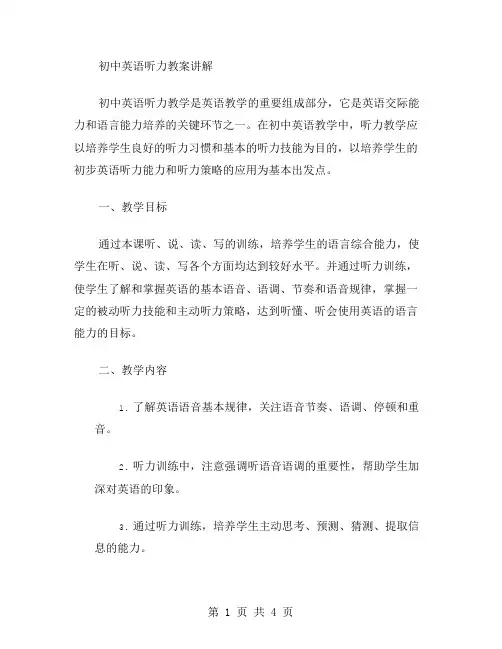
初中英语听力教案讲解初中英语听力教学是英语教学的重要组成部分,它是英语交际能力和语言能力培养的关键环节之一。
在初中英语教学中,听力教学应以培养学生良好的听力习惯和基本的听力技能为目的,以培养学生的初步英语听力能力和听力策略的应用为基本出发点。
一、教学目标通过本课听、说、读、写的训练,培养学生的语言综合能力,使学生在听、说、读、写各个方面均达到较好水平。
并通过听力训练,使学生了解和掌握英语的基本语音、语调、节奏和语音规律,掌握一定的被动听力技能和主动听力策略,达到听懂、听会使用英语的语言能力的目标。
二、教学内容1.了解英语语音基本规律,关注语音节奏、语调、停顿和重音。
2.听力训练中,注意强调听语音语调的重要性,帮助学生加深对英语的印象。
3.通过听力训练,培养学生主动思考、预测、猜测、提取信息的能力。
4.着重训练学生听懂简单英语口语,如交际用语、常用句型、认知词汇等。
5.引导学生掌握听力技巧,如寻找主要信息,留心关键词汇,注意上下文的逻辑关系等。
三、教学方法1.讲授法:教师通过精讲、示范、指导,让学生了解和领悟英语听力技巧和策略。
通过例题的讲解,让学生掌握英语语音的发音特点、语调及句式使用频率。
2.练习法:通过各类听力练习,帮助学生掌握英语听力技能和策略,在练习中提高学生的听力水平。
3.对话法:教师通过对话形式,引导学生模拟和积极参与英语口语对话,培养学生口语表达能力和听说能力。
4.情景法:教师通过低龄化和日常生活情境化教学手段,使学生在轻松愉快的氛围中,掌握听力技巧和策略。
四、教学步骤(一)引入教师可通过播放英语听力材料,让学生初步了解英语口语,引导学生对英语听说有一定的兴趣和好奇心。
(二)讲授教师通过示范、指导等手段,让学生了解和掌握课文的内容。
同时,教师可通过讲解英语语音发音特点、语调的使用、句式使用频率等方面,让学生进一步掌握英语听力技巧和策略。
(三)练习教师可通过听力练习、场景练习、对话练习等方式,帮助学生提高听力水平。
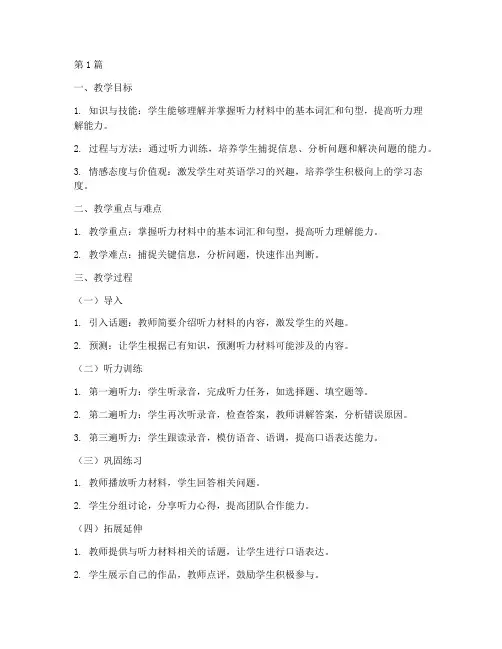
第1篇一、教学目标1. 知识与技能:学生能够理解并掌握听力材料中的基本词汇和句型,提高听力理解能力。
2. 过程与方法:通过听力训练,培养学生捕捉信息、分析问题和解决问题的能力。
3. 情感态度与价值观:激发学生对英语学习的兴趣,培养学生积极向上的学习态度。
二、教学重点与难点1. 教学重点:掌握听力材料中的基本词汇和句型,提高听力理解能力。
2. 教学难点:捕捉关键信息,分析问题,快速作出判断。
三、教学过程(一)导入1. 引入话题:教师简要介绍听力材料的内容,激发学生的兴趣。
2. 预测:让学生根据已有知识,预测听力材料可能涉及的内容。
(二)听力训练1. 第一遍听力:学生听录音,完成听力任务,如选择题、填空题等。
2. 第二遍听力:学生再次听录音,检查答案,教师讲解答案,分析错误原因。
3. 第三遍听力:学生跟读录音,模仿语音、语调,提高口语表达能力。
(三)巩固练习1. 教师播放听力材料,学生回答相关问题。
2. 学生分组讨论,分享听力心得,提高团队合作能力。
(四)拓展延伸1. 教师提供与听力材料相关的话题,让学生进行口语表达。
2. 学生展示自己的作品,教师点评,鼓励学生积极参与。
四、教学评价1. 课堂表现:观察学生在课堂上的参与度、合作精神等。
2. 听力测试:通过听力测试,评估学生的听力理解能力。
3. 作业完成情况:检查学生完成作业的质量,了解学生的学习情况。
五、教学反思1. 教师分析教学效果,总结教学经验,改进教学方法。
2. 学生反思自己的学习过程,找出不足,制定改进措施。
以下为具体教案示例:教案示例一、教学目标1. 学生能够理解并掌握听力材料中的基本词汇和句型。
2. 学生能够提高听力理解能力,捕捉关键信息。
3. 激发学生对英语学习的兴趣,培养学生积极向上的学习态度。
二、教学重点与难点1. 教学重点:掌握听力材料中的基本词汇和句型。
2. 教学难点:捕捉关键信息,分析问题,快速作出判断。
三、教学过程(一)导入1. 教师简要介绍听力材料的内容,激发学生的兴趣。
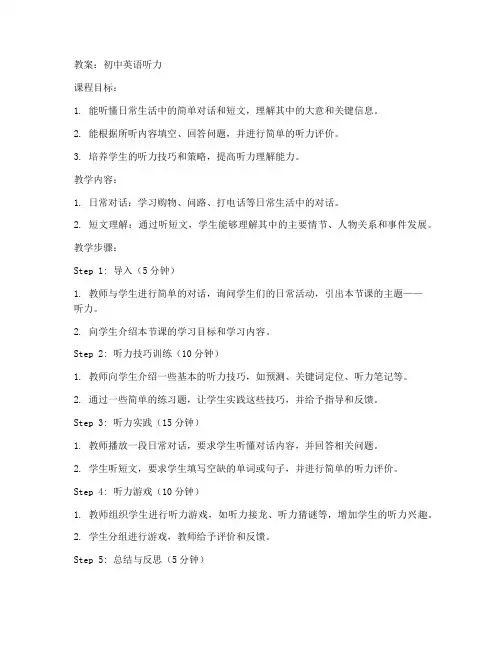
教案:初中英语听力课程目标:1. 能听懂日常生活中的简单对话和短文,理解其中的大意和关键信息。
2. 能根据所听内容填空、回答问题,并进行简单的听力评价。
3. 培养学生的听力技巧和策略,提高听力理解能力。
教学内容:1. 日常对话:学习购物、问路、打电话等日常生活中的对话。
2. 短文理解:通过听短文,学生能够理解其中的主要情节、人物关系和事件发展。
教学步骤:Step 1: 导入(5分钟)1. 教师与学生进行简单的对话,询问学生们的日常活动,引出本节课的主题——听力。
2. 向学生介绍本节课的学习目标和学习内容。
Step 2: 听力技巧训练(10分钟)1. 教师向学生介绍一些基本的听力技巧,如预测、关键词定位、听力笔记等。
2. 通过一些简单的练习题,让学生实践这些技巧,并给予指导和反馈。
Step 3: 听力实践(15分钟)1. 教师播放一段日常对话,要求学生听懂对话内容,并回答相关问题。
2. 学生听短文,要求学生填写空缺的单词或句子,并进行简单的听力评价。
Step 4: 听力游戏(10分钟)1. 教师组织学生进行听力游戏,如听力接龙、听力猜谜等,增加学生的听力兴趣。
2. 学生分组进行游戏,教师给予评价和反馈。
Step 5: 总结与反思(5分钟)1. 教师与学生一起总结本节课的学习内容和成果,鼓励学生分享自己的学习心得和体会。
2. 教师布置课后作业,要求学生复习本节课的学习内容,并进行听力练习。
教学评价:1. 课堂参与度:观察学生在课堂上的积极参与程度和表现。
2. 听力练习结果:评估学生在听力练习中的表现,包括答案的正确性和听力技巧的运用。
3. 课后作业:检查学生的课后作业完成情况,了解学生对课堂学习的掌握程度。
教学资源:1. 听力材料:日常对话和短文,包括购物、问路、打电话等日常生活中的对话。
2. 听力练习题:与教学内容相关的一些练习题,用于学生的听力技巧训练和听力实践。
3. 听力游戏:一些听力游戏活动,如听力接龙、听力猜谜等。
初中英语语音教案模板〔共3篇〕第1篇:初中英语语音试讲教案初中英语语音试讲教案【篇1:初中英语面试教案万能模板】teaching aims: knowledge aim:students will know lin fei’s daily life and some good habits at their home. ability aim:students will improve their listening and speaking skills. emotional aim:after this leon students would like to learn to arrange their life and form good habit in the daily life. teaching key and difficult points: teaching key points:students will understand this paage by listening and make a time line of lin fei’s life. teach ing difficult points:how to describe their own life style of the school day? teaching procedures: step 1 warming-updo a survey: ask students to fill the questionnaire (with different daily activities and time point, students just need to mark the activities in their time) and invite some students to share.step 2 pre-listeningshow some pictures about lin fei’s day and ask students “what does lin fei do in a day? step 3while-listeningplay the tape recorder and ask students some question. q: what is the distance between his school and home?play the tape recorder another time and give students some other questions to practice their listening again. q1: when should lin fei go to school?q2: how long will it take lin fei to ride to the bus station?listen to the tape for the third time and then students should describe lin fei’s daily life intheir own words.they will have 3 mines to prepare it. step 4 post-listening ask students to look their questionnaires which they filled at the beginning ofthe cla and give them 5 min to make a short story of their daily life, later some students will share the stories in front of the cla.teacher should give them a guidance of health life style. step 5 summary and homeworksummarize this leon with students, and then ask them to design a new schedule of their daily lifeafter the cla, they will share during next leon, they also need to read the new paage two times to consolidate the new knowledge. blackboard design teaching reflection【篇2:初中英语语法宾语从句试讲教案】宾语从句教学设计一、导入1.复习什么是宾语。
听力教学试讲1.Teaching aims1)Knowledge aimsStudents can master sentence patterns,“I’m going to....”,and learn the simple future tense.2)Ability aimsStudents can talk about future by using the new sentence patterns smoothly,and improve their listening and speaking skills.3)Emotional aimStudents can learn to know their own dream,and study harder to make it come true.2.Teaching key and difficult points1)Key pointHelp students to master sentence patterns,“I’m going to....”,and learn the simple future tense.2)Difficult pointHelp students to put what they’ve learned into practice,and communicate with others freely.3.Teaching and learning methodsTask-based teaching method;Question and answer method;Group work method;Cooperative learning method;Independent learning method.4.Teaching proceduresStep1:Lead inAt the beginning of the class,teacher will show some pictures about jobs,and and lead the students to talk about dream.Step2:Pre-listeningStudents will to talk about their dreams,and how they are going to do that.Step3:While-listening1)Extensive listening.Students need to listen the tape for the first time and find out what the listening material is talking about.2)Intensive listening2)Intensive listening.Students will listen the passage intensively,and answer three questions.3)listening and Reading.Students will listen to the tape and read after it for the last time.Step4:Post-listening1)Retelling.Students will retell the whole passage in groups.2)Brainstorming.Students will make a survey about their dream and how to make it come true.Step5:Summary and homeworkI lead them to summarize what they have learned in this class.Homework:read the passage for three times,and make a survey abouttheir family’s dream.5.Blackboard designQ1:Which city is the author going to move when he grow up? Q2:Is the author going to hold art exhibitions?And why? Q3:What does the author want to be?听力教学试讲GreetingGood morning,boys and girls!How are you today?Great,not bad.I’m so glad to hear that.Step1:Leading-inNow,look at the pictures on the screen,what can you see?Yes,so many different people,and different jobs.Jacky,please.Can you tell me you know?Yes,teacher,worker,policeman,well,do you want to be a policeman when you grow up?Yes,so cool.How about Lily?Wow,you want to be a dancer,wow,great.Anything else?The girl in red,please. You want to be a teacher,just like me.Why?Because you like children, and teaching,hmm,me too.You are so sweet.I believe everyone has his own dream when you grow up.Today,let’s see the author’s dream,and how he is going to do that?Here we go.Step2:Pre-listeningNow,imagine you want to be a reporter when you grow up,how are you going to do that?Two minutes for you.You can discuss with your classmates.Are you clear?Now,you can start.OK,time’s up.Now, who can share your idea?Wow,Mike,you are so active.Maybe,you can join the music club in our school,oh,nice work.Well,Any volunteers?Hmm,you all did a good job.Now,let’s learn more about this topic.Here we go.Step3:While-listening1)Now,listen to the tape for the first time,and then tell me what is the passage mainly talking about?ready?Go.OK,stop here.who can try?Don’t be shy.Mike,please.Yes,the author wants ot be a reporter for a fashion magazine,and how he is going to do it.Guys,do you agree with him?Yes,you are right.2)Now let's listen to the tape for the second time and answer my questions:Q1:Which city is the author going to move when he grow up? Q2:Is the author going to hold art exhibitions?And why?Q3:What does the author want to be?Are you clear?Let's begin.OK stop here. Now,the first question?Any volunteers?OK,Ben you please.bingo.He is going to move somewhere interesting,just like Paris.When someone wants to talk about something about future,we can say,great,“I’m going to....”,we call it the simple future tense.Now,who wants to make a sentence for us?Alan,please.“I’m going to see my grandpa next weekend?”Is he right?Yes,well done.the next question?Maybe it’s a little difficult for you.Think it over.Jacky,please.No,he is going to move somewhere interesting.Hmm,any other opinions?Grace,please.Yes,he is,because he wants to be famous.right?Yes,I totally agree with you. Jacky,can you repeat?Good.You have done well,and I believe you will do better next time.Right?Come on.Now,last question?Say it together....yes,a reporter.Let me give you a big hand.Now,I believe allof you have understood the passage and learned how to talk about future using the sentence pattern“I’m going to....”3)OK,guys,I will play the radio,and you need to listen to the tape for the last time,and read after the passage loudly.At the same time, please pay more attention to the pronunciation and intonation.Ready? Go...stop here.Wow,your pronunciation and intonation are pretty good. Step4:Post-listening1)Practice makes perfect!Firstly,let’s retell the passage.Now close your book,and look at the PowerPoint,there are some key words and sentences.try to retell the whole passage.five minutes for you to prepare. Then I will invite some students to perform in the front of the classroom. Understand?You can start...time’s up.Who wants to try?Tom,you are so active.Please come here.Wow,I like your pronunciation.Thank you.Go back to your seat.Next group?Wow,Susan,Your statement is very close to the original.Do you agree with me?Yes.Good,go back to your seats. Let’s give them a big hand.2)Hey,boys and girls,do you want to play a game?Yes,I think all of you like it.Now,let’s do a brainstorming game.This time,six students in small groups.Discuss what your partner wants to be,and how he or she is going to do that,write them down on your notebook,still using the sentence What would you like?I’d like...clear?Then I will select the representatives of each group to report and see which group thinks fastand more.Understand?Six minutes for you.Fighting.Finished?Your hands are very high.Alice,please.Hmm,your partner Alan wants to be a policeman,and he is going to study harder and harder.....wow,so cool,it seems like your group have so many dream.Right?So great.Next?Gina, please.Football player,singer,dancer...wow,It's wonderful.Maybe some day,you can make it,yes?Hmm.Step5:Summary and homework1)SummaryTime goes so fast!Now,who can summarize what we have learned this class?OK,Alan,please.Bingo.Yes,We have learn a passage about author’s dream when he grows up.Anything else?Selina,please.We have also learned how to talk about future in English.When you want to talk about future,you can use the simple future tense,“I’m going to....”I know everyone has your own dream,and if you want to make it come true,we should study hard from now on,right?Yes.2)HomeworkAs for today's homework,the first one is to listen to the passage for three times,and the second one is to make a survey about your family’s dream,then share it with others next time.Am I clear?Good.OK,class is over.See you next time.That’s all.Thank you for your listening.Blackboard designQ1:Which city is the author going to move when he grow up? Q2:Is the author going to hold art exhibitions?And why? Q3:What does the author want to be?。
初中英语听说课面试教案模板(共11篇)初中英语听说课教案《Unit 5 Could you please tell me where the》上传: 张爱萍更新时间:2012-5-21 10:55:23初中英语听说课教案unit 5 could you please tell me where the鹅湖中学:张爱萍知识目标:1、知识目标:学习使用uncrowded, safe, fascinating, inexpensive, delicious, convenient 等形容词描述介绍各种场所。
能力目标:2、能力目标:1)能够听懂询问信息的句型并会用英语提供帮助。
2)学会准确描述地理位置,并给他人指路,提供帮助。
教法情感目标:3、情感目标:通过学习让学生学会有礼貌地向他人询问信息,帮助别人。
学会如何有礼貌地与人交流相处。
1) 视听法:主要通过多媒体课件展示、图片展示、老师提问、学生回答等方式提供让学生看、听、说的练习机会2)问答法:展示各种图片,让学生利用这些图片进行交流,互学法相问答,让学生在做中学,在实践中获得信息,习得英语。
3)实施情境教学法4)采用任务型语言教学多媒体录音机学具师生活动设计1)学生课前预习法2)小组合作探究法3)情感激励法教具教学程序设计教材处理设计课件一、谈图片,谈图片,复习热身step1 warming up :复习热身greet the cla.look at the pictures.【出示section a 中2a 的图片, 让学生思考, 准备介绍分别可以在哪买到book,shoes, shampoo 等物品,如何找到该地方。
复习前面学过的句型,为本课的顺利进行,尤其是听力的顺利展开打好基础。
…… 】老师出示一些商业店铺的图片,学生两人一组练习:该在哪里买到相应物品?如何到达目的地?即练习问路的表达法和如何指路的表达法。
复习where, how 引导的宾语从句。
初中英语试讲听说课稿子同学们,今天我们要进行一节初中英语的听说课。
这节课的主题是“日常生活”,我们将通过听和说的练习来提高我们的英语听力和口语能力。
首先,让我们来听一段对话。
这段对话发生在一家餐厅,两位朋友正在讨论他们的食物和饮料。
请大家仔细听,注意他们使用的词汇和句型。
[播放对话录音]现在,我们已经听过了这段对话。
接下来,请大家尝试回答以下几个问题:1. 他们点了什么食物?2. 他们点了什么饮料?3. 他们对食物和服务有什么评价?[等待学生回答]很好,现在让我们来练习一下口语。
我们将分成小组,每组模拟在餐厅点餐的场景。
每组需要选出一位服务员和一位顾客。
服务员需要询问顾客想要点什么,并给出一些建议。
顾客则需要表达自己的需求和偏好。
[学生分组练习]在练习过程中,请大家注意以下几点:- 使用正确的时态和语态。
- 注意使用礼貌用语,如“Could I have...”或“Would you like...”。
- 尝试使用不同的句型和词汇来表达相同的意思。
[学生练习结束后]现在,让我们来总结一下今天学到的内容。
我们学习了如何在餐厅点餐,包括询问和提供信息的句型。
我们还练习了听力,通过听一段对话来理解对话内容。
希望你们能够将今天学到的知识应用到实际生活中。
最后,给大家布置一个小任务:回家后,尝试和家人或朋友用英语进行一次点餐的对话,并记录下来。
下次课上,我们可以分享我们的对话。
这节课就到这里,希望大家都能够有所收获。
下课!。
教学对象:初中一年级教学目标:1. 培养学生对英语听力的兴趣,提高听力技能。
2. 通过听力练习,帮助学生掌握基本的听力技巧,提高理解能力。
3. 增强学生的口语表达能力,提高实际运用英语的能力。
教学重点:1. 培养学生正确的听力技巧,如:预测、听关键词、注意句子结构等。
2. 提高学生对不同语境下英语听力的理解能力。
教学难点:1. 培养学生良好的听力习惯,克服听力障碍。
2. 在实际语境中,提高学生的口语表达能力。
教学准备:1. 多媒体设备,如电脑、投影仪等。
2. 英语听力材料,如录音带、MP3等。
3. 教学课件。
教学过程:一、导入1. 老师用英语进行简单的自我介绍,激发学生的学习兴趣。
2. 提问:同学们,你们喜欢听英语吗?为什么?二、听力训练1. 老师播放一段简单的英语对话,让学生初步感知英语听力。
2. 学生听后,回答问题,如:What's this dialogue about? Who are they? What are they talking about?3. 老师针对学生的回答进行点评,纠正发音和语法错误。
三、听力技巧讲解1. 老师讲解听力技巧,如:预测、听关键词、注意句子结构等。
2. 通过实例,让学生了解如何运用这些技巧。
四、听力练习1. 老师播放一段较长的英语对话,要求学生边听边记录关键词。
2. 学生完成记录后,分享自己的答案,老师点评。
五、口语表达训练1. 老师给出一个话题,要求学生根据听力材料进行口语表达。
2. 学生进行小组讨论,互相交流,提高口语表达能力。
六、总结1. 老师总结本节课的重点内容,强调听力技巧的重要性。
2. 鼓励学生在课后进行听力练习,提高自己的英语听力水平。
教学反思:1. 在导入环节,要注意激发学生的学习兴趣,让他们积极参与课堂活动。
2. 在听力训练环节,要关注学生的听力技巧,及时纠正发音和语法错误。
3. 在口语表达训练环节,要鼓励学生大胆开口,提高他们的口语表达能力。
初中英语教师招聘面试试讲稿(教案)33套初中英语教师招聘面试试讲稿(教案)33套一、自我介绍大家好,我是XXX。
首先非常感谢各位面试官给我这个机会,让我有机会展示我的教学理念和教学能力。
我担心这个试讲因为我的英语水平有限而没有完全展示出我所希望的效果,但我会尽我最大的努力。
接下来,我将向大家介绍我的试讲内容。
二、试讲内容课程目标通过本课的研究,学生能够:- 掌握词汇与语法知识- 熟练运用所学内容进行口语表达- 培养阅读和听力技能课程准备- PowerPoint幻灯片:使用图片和简单的英语单词进行展示,激发学生的研究兴趣- 学生练:准备练册,让学生进行口语练和听力训练- 板书:使用简单的词汇和句子,帮助学生记忆和理解重点内容课程内容Step 1: 导入利用一些有趣的图片和对象引起学生的兴趣,并引导学生使用简单的英语单词进行描述。
Step 2: 词汇与表达介绍一些基础的英语词汇和表达,例如颜色、形状、动物等。
通过展示图片和听力练,让学生熟悉这些词汇,并能用英语进行简单的交流。
Step 3: 句子构建引导学生将学到的词汇组合成简单的句子。
例如,使用颜色和形状词汇描述物体。
通过说故事、问答等方式,培养学生用英语进行基本的口语表达。
Step 4: 阅读理解选取一篇简短的英语短文或对话,让学生在听读的同时理解其中的意思。
通过提问和讨论,加深学生对内容的理解程度。
Step 5: 训练与巩固进行口语练、听力训练,并通过学生练册进行巩固练。
提供反馈和指导,帮助学生提高口语和听力技能。
课程总结通过本课的研究,我们帮助学生掌握了一些基础的英语词汇和句子结构,培养了学生的口语和听力技能,并提高了他们对英语的理解能力。
希望学生能够继续用心研究英语,探索更广阔的语言世界。
三、教学理念我的教学理念是注重学生的主动参与和实际运用能力的培养。
通过创设情境和活动,激发学生的研究热情,提高他们的研究积极性。
同时,我也鼓励学生积极思考和表达,培养他们的自信心和创造力。
20 年 月 日
A4打印 / 可编辑
初中英语教师资格面试《LinFeisdailylife
》教案
初中英语教师资格面试《Lin Fei’s daily life》
教案
2016下半年教师资格面试备考已经拉开序幕,一篇优秀的教案对面试的成功是非常重要的,国家教师资格考试网特为考生献上初中英语教师资格面试《Lin Fei’s daily life》教案,希望对大家有所帮助。
Lin Fei’s daily life teaching plan
Teaching Aims:
Knowledge aim: Students will know Lin Fei’s daily life and some good habits at their home.
Ability aim: Students will improve their listening and speaking skills.
Emotional aim: After this lesson students would like to learn to arrange their life and form good habit in the daily life.
Teaching Key Points:
Students will understand this passage by listening and make a time line of Lin Fei’s life.
Teaching Difficult Points:
How to describe their own life style of the school day?
Teaching Procedures:
Step 1 Warming-up
Do a survey: ask students to fill the questionnaire (with different daily activities and time point, students just need to mark the activities in their time) and invite some students to share.
Step 2 Pre-listening
Show some pictures about Lin Fei’s day and ask students “what does Lin Fei do in a day?
Step 3 While-listening
Play the tape recorder and ask students some question.
Q: What is the distance between his school and home?
Play the tape recorder another time and give students some other questions to practice their listening again.
Q1: When should Lin Fei go to school?
Q2: How long will it take Lin Fei to ride to the bus station?
Listen to the tape for the third time and then students should describe Lin Fei’s daily life in their own words. They will have 3 mines to prepare it.
Step 4 Post-listening
Ask students to look their questionnaires which they filled at the beginning of the class and give them 5 min to make a short story of their daily life, later some students will share the stories in front of the class.
Teacher should give them a guidance of health life style.
Step 5 Summary and homework
Summarize this lesson with students, and then ask them to design a new schedule of their daily life after the class, they will share during next lesson, they also need to read the new passage two times to consolidate the new knowledge.
Blackboard Design:
Teaching Reflection:
整理丨尼克
本文档信息来自于网络,如您发现内容不准确或不完善,欢迎您联系我修正;如您发现内容涉嫌侵权,请与我们联系,我们将按照相关法律规定及时处理。